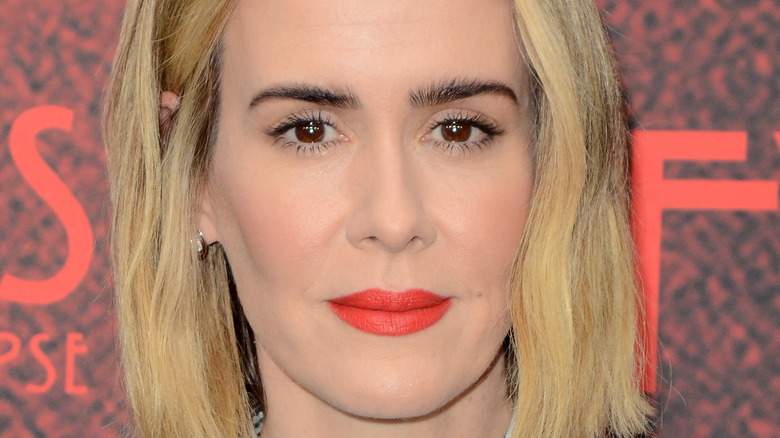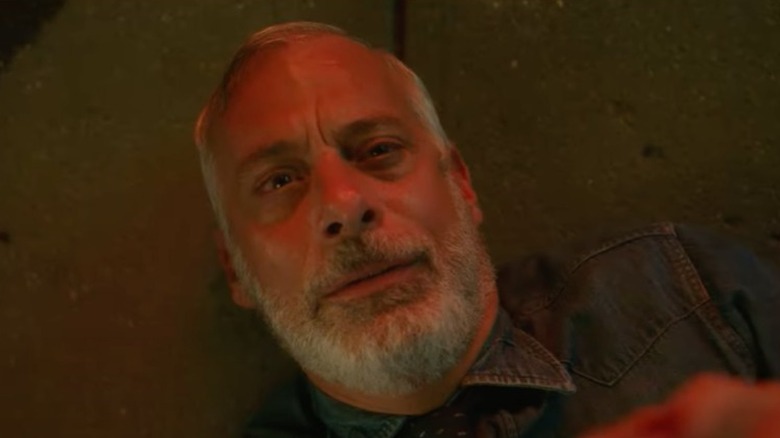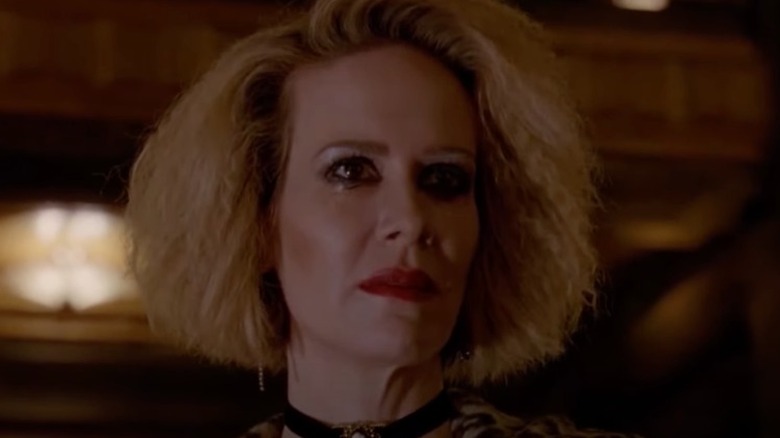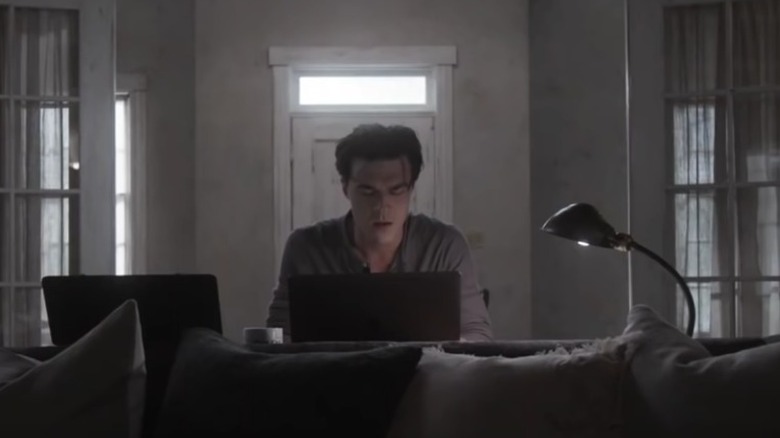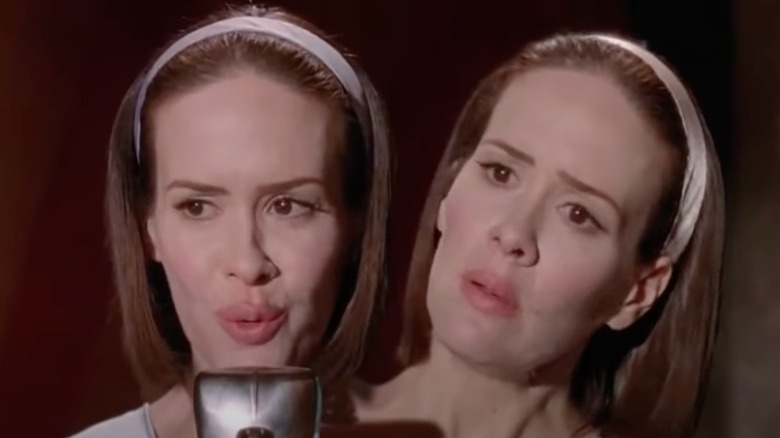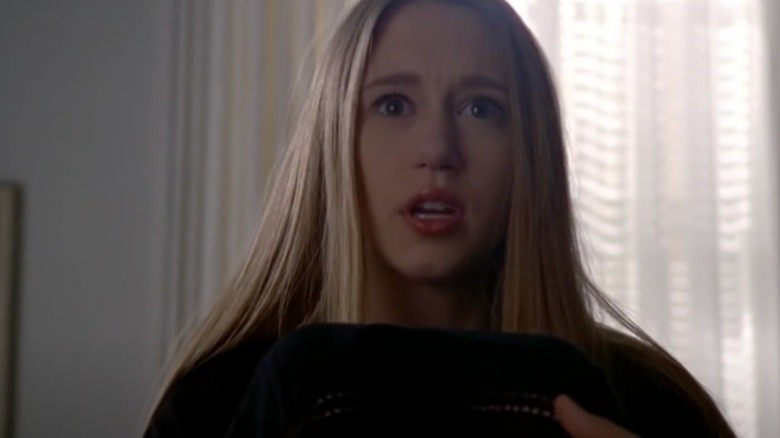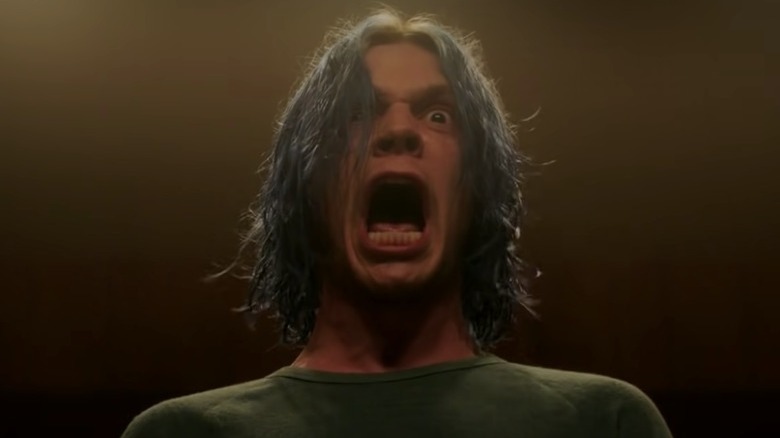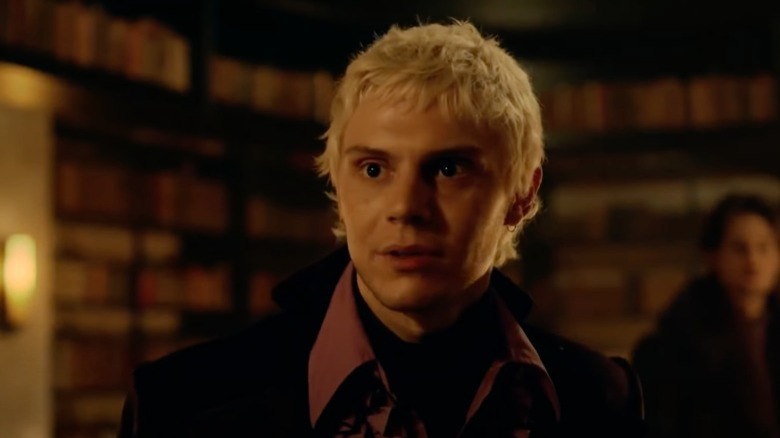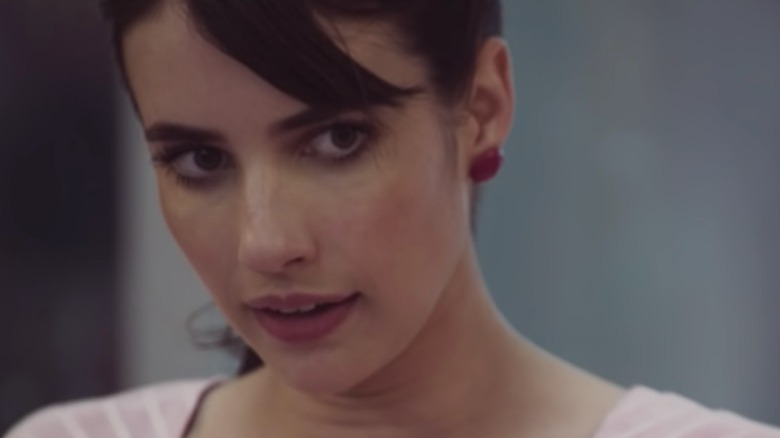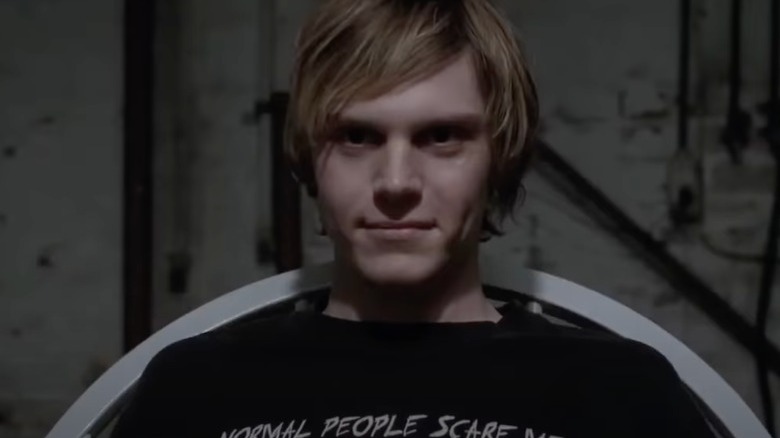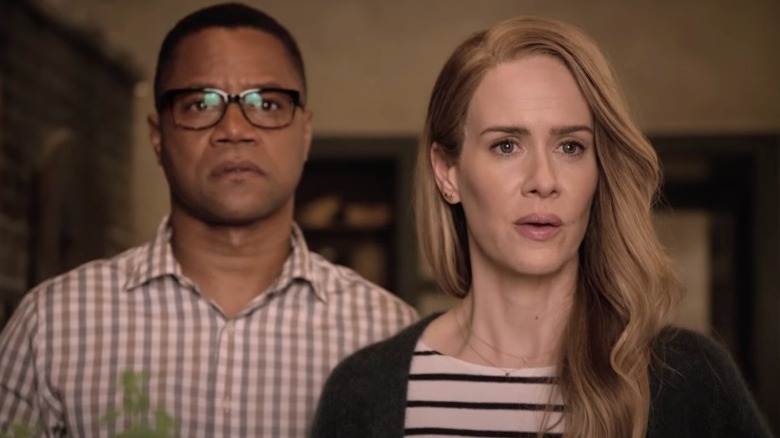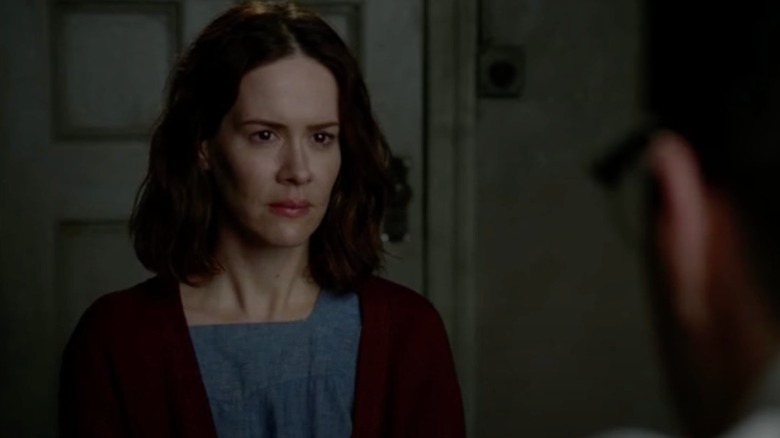Every American Horror Story Season Ranked By Scariness
For 11 seasons, fans of "American Horror Story" have fallen prey to the creators' fearsome plots and infamous characters. Creators Ryan Murphy and Brad Falchuk use potentially scary situations and current events to reel in audiences and make unforgettable season-long storylines.
Despite being around since 2011, "American Horror Story" has continued to give audiences new ideas. What's not so new about the show, though, are the faces fans are used to seeing each season. As an anthology series, each season is unrelated to the last. However, actors like Evan Peters, Sarah Paulson, Lily Rabe, Frances Conroy, and Denis O'Hare have each appeared in more than eight of the 11 seasons.
With so many seasons of "American Horror Story," though, there are bound to be seasons that are scarier than others. Overall, each concept could affect fans differently — some fans are more scared of clowns and witches, where others fear settings like slasher-stalked summer camps and haunted mental asylums more. However, in terms of general fear factor, script development, and characters that uneasily stick with you, here are all 11 seasons of "American Horror Story" ranked from least to most scary.
11. NYC
The most recent season of the show, "AHS: NYC," lacks a scare-factor. The season is set at the height of the AIDS epidemic and follows a string of mysterious disappearances and eventual deaths that are connected through one serial killer targeting gay clubs and leather-fetish bars. While a coupled reporter and a police officer work to investigate these tragedies, at the same time, there's an unknown virus beginning to wreak havoc on New York City that may or may not be a product of the U.S. government.
"AHS: NYC" is more rooted in reality than in supernatural elements. Though there are many seasons where "AHS" brings in realistic plot lines and sparks fear, this season feels more forced than anything else. The queer representation and casting is a major plus, but the string of killings of queer people in the season released during a real-world climate where queer people are targeted by lawmakers and elected officials is more than a bit upsetting. More than that, though, the incorporation of COVID-19 or virus-related storylines into fictional media is wildly overdone at this point, so it takes the audience out of the story a bit and takes away from the fear-factor.
10. Hotel
Season 5 of "American Horror Story" is called "Hotel," which follows the Hotel Cortez in Los Angeles. After a series of murders and mysterious happenings garner the attention of a homicide detective (Wes Bentley), the supernatural activities of the Hotel Cortez are uncovered and the nefarious intentions of the Countess (Lady Gaga) and her vampiric family are investigated. According to Murphy and Falchuk, this season is partially based on the Cecil Hotel in Los Angeles. This hotel experienced many deaths and other nefarious events, but it also housed serial killer Richard Ramirez during the '80s while he was on his spree. "AHS: Hotel" portrays this, too, with Anthony Ruivivar playing the killer.
There are many ghosts, real-life figures, and paranormal factors that go into making this season scary. However, the focus is clearly more on the setting rather than the story, with intricate sets, costumes, and other technical elements that take attention away from the plot. The season — especially considering Gaga's fabulousness and vampiric tendencies — comes across more as camp than as serious horror, and some of the elements aren't scary at all. When something earns camp status, it's hard to have any serious horror.
9. Double Feature
The first deadly wave of the coronavirus pandemic in 2020 made it very difficult for creators to film their television shows and movies. Considering all the additional complications, it's not really surprising that 2021's Season 10 of "AHS" comes across as a bit lackluster. The season has two different storylines, and it's appropriately subtitled "Double Feature."
The first part, called "Red Tide," follows a family that moves out by the sea in Massachusetts so the father, Harry (Finn Wittrock), can write his book. However, after meeting the eclectic townies and being faced with writer's block, Harry decides to take a pill called Muse that's meant to bring out his creativity. The pill, though, comes with a price — a lust for blood.
The second part, "Death Valley" centers around the government conspiracy and cover-ups of alien activity. Set during Dwight Eisenhower and Lyndon B. Johnson's presidencies, this half of the season leans deeply into government conspiracies including Amelia Earhart's disappearance.
The writing of this season feels disconnected and discombobulated. Though the "Double Feature" idea has potential, it isn't as scary as it could've been. The "Red Tide" has some scary moments, but otherwise the show perpetuates the idea of government conspiracies at a time where that's become incredibly divisive, making it feel tonally insensitive.
8. Freak Show
"AHS: Freak Show" is the fourth season of the anthology series. The season follows a circus troupe led by the illustrious Elsa (Jessica Lange) as they try to stay afloat amid little fan interest. The troupe takes in conjoined twins Bette and Dot (Paulson), hoping they'll be the new act that bring in the crowds. At the same time, a killer clown named Twisty (John Carroll Lynch) wreaks havoc on the town where the troupe has settled, and a wealthy mother and son attempt to buy some of Elsa's acts for their personal enjoyment.
The circus setting and the inclusion of the different freaky characters make for a good concept, but the overall execution isn't scary. "Freak Show" and "Double Feature" are pretty evenly matched, but the only reason "Freak Show" wins out is because of Lynch's performance as Twisty. He brings a compelling nature to this terrifying character, and for an actor to portray such horror and expressiveness while being almost fully masked by the costume is wildly impressive. Twisty not only makes "Freak Show" scary, but he's the main reason it's memorable.
7. Coven
One of the best seasons of the entire show is "AHS: Coven," the third installment of the series. The season follows a coven of witches based in New Orleans. The coven — all descendants of witches that resided in colonial Salem, Massachusetts — are fighting to survive in a modern world. The witches make specific relationships with each other — some are friends, some are adversaries — and they train to see who will become the next supreme witch. Additionally, the audience sees Salem witch trials from the 1600s, as well as events from the 1800s and 1900s that tie into the Salem descendants we focus on this season.
"Coven" is written beautifully and has amazing characters. However, in terms of scare-factor, this season is not scary. The witch trials are chilling, especially because they happened in real life, but this season offers more of a lighter horror. There are '70s hippie vibes, relationship developments, and more of a free-spirited aesthetic that is more of a comfort watch than a discomfort watch.
6. Cult
This is where the show starts to be particularly scary. Season 7 of "AHS" is called "Cult" and is rooted in the 2016 presidential election of Donald Trump. Set in 2017, "Cult" follows a group of people in a Michigan suburb who are reeling after the election — particularly a queer married couple named Ally (Paulson) and Ivy (Alison Pill). After Trump is elected, some people feel horror and worry and wonder what it means for the fate of the country, while another group of people, um ... well, let's just say they feel differently about the outcome of the election. A cult of Trump supporters begins making life unsafe and miserable for the suburb's residents while trying to recruit people to their cause. From there, it's a suburban war that brings death, turmoil, and boatloads of fear.
This season is obviously based in reality and what was actually happening in the country at the time. Some folks might even suggest that "AHS: Cult" is more prescient than Ryan Murphy and his writing team could've possibly intended. As people are still living in the results of the election from 2016, it makes sense that this would be a real fear-filled season.
5. Apocalypse
"AHS: Apocalypse" is Season 8 of "American Horror Story," and is different from every other season because it finds a way to tie in elements from other seasons. Fans of "AHS" will see characters and storylines from Season 1, "Murder House," Season 3, "Coven," and Season 5, "Hotel." The season follows a group of people who, thanks to their riches and connections, escape the nuclear apocalypse by living in an underground bunker called the Outpost. With limited supplies and severe rules, the Outpost becomes a virtual prison that keeps its inhabitants alive but not happy. That is until Michael Langdon (Cody Fern), the antichrist, shows up.
The idea of the apocalypse is terrifying, and that aspect of it is very present. Off the bat, the season presents the audience with "What Would You Do?"-type questions. Because it's set in an underground bunker, "Apocalypse" also makes the audience feel really claustrophobic and trapped, which definitely contributes to the scare factor. Plus, Michael Langdon himself is an extremely horrifying portrayal of the antichrist who also happens to be fabulous.
4. 1984
The ninth season of "AHS" is called "1984." Set in that year, "1984" follows Brooke (Emma Roberts) and her friends as they head to Camp Redwood to work as counselors. They all could use an escape with serial killer Richard Ramirez (Zach Villa) on the loose. The group learns the lore of the camp, including the disturbing history of Mr. Jingles (John Carroll Lynch), who coincidentally escapes from the asylum right around the same time the kids gather for summer camp. The counselors and adults of Camp Redwood must survive the horrors of the camp and the loose killer or face gruesome consequences.
This approach of this season is more influenced by slasher movies than psychological or supernatural terror. The audience expects more jump scares and anxiety about which character will be killed off next. It's a great season with excellent nods to genre classics — especially the iconic summer camp setting — and it gives Roberts a lot of great space to act. The entire cast does a wonderful job embodying different '80s movie archetypes, and the strong characters allow the audience to get immersed in the horror and invested in who lives and who dies.
3. Murder House
The first season of "AHS" might be the most memorable and fully developed. "Murder House" follows the Harmon family — Vivien (Connie Britton), Ben (Dylan McDermott), and their daughter Violet (Taissa Farmiga) — who move to a house in Los Angeles that is peculiar. Soon the family starts to encounter ghosts of those who lived and died in the house. Some of the ghosts are friendly; some are decisively not. All the while, the Harmons deal with their own emotional problems, including Ben's affair with one of his students, Vivien's miscarriage, and Violet's depression. Through flashback stories, the audience learns just how murderous the Harmons' house can be.
This season plays out perfectly. The ghosts and their individual stories juxtaposed with the Harmon family and their outlandish neighbors create an amazing and engaging tale. At the same time, the reliance on the supernatural and real-life horrors come together to create a terrifying season. There is no shortage of scares throughout this season, and a lot of that comes from the visual horror as well as the psychological elements. It's brilliantly done and so scary that it sticks with you for a while after watching.
2. Roanoke
The sixth season of "AHS" is called "Roanoke." It follows the supernatural happenings at a farmhouse in North Carolina where a couple go public about the horrors they experience while living there. The story becomes a documentary series called "My Roanoke Nightmare," which includes reenactments of the real people's accounts of the violent and ghostly events. Halfway through the season, the documentary series becomes so successful that they make a spinoff called "Return to Roanoke: Three Days in Hell," which brings back the reenactment actors to go to the actual farmhouse during the blood moon and try to survive the disastrous stay. The real Millers are also a part of the equation, and the events that follow are horrific and bloody.
This season has slasher elements, demonic elements, and psychological fear. It's also without a doubt the most inventive and fun season and it's armed with a great story and collection of stellar performances. The way they are able to utilize the mockumentary style and show both the fake and real happenings of Roanoke is brilliant. Each episode brings new twists and turns that leave the audience horrified. It's definitely scarier than the rest of the seasons, save for one.
1. Asylum
The second season of "AHS" is set in a mental institution in the '60s and it's called "Asylum." This season features a collection of people who genuinely need psychiatric help, as well as some folks who are wrongfully accused of being insane, as was sometimes the reality at that point in history. One patient, Kit (Peters) claims his wife was abducted by aliens, and the story includes a lesbian journalist named Lana (Paulson) who is trying to find the perfect story to make a name for herself. She embeds herself within the asylum to learn more and write the story, but soon realizes a group of nuns, the evil Dr. Arden, and disturbed psychiatrist Oliver Thredson (Zachary Quinto) aren't conducting ethical operations within the asylum. Lana and the others must survive the man-made horrors and the supernatural torment that attacks them within Briarcliff Manor.
This season is no doubt the scariest. It's rooted in reality, especially regarding the institutionalization of folks who clearly don't need to be locked up, and it also has a lot of spooky supernatural elements. Being set in the past, it's also a bit terrifying because there's a lack of technology to help people and a lack of knowledge to properly treat them in medical settings. The characters are more sinister and twisted in this season than any other, and the way the story unfolds and develops throughout the episodes keeps the audience half watching, and half hiding behind a blanket for protection.
